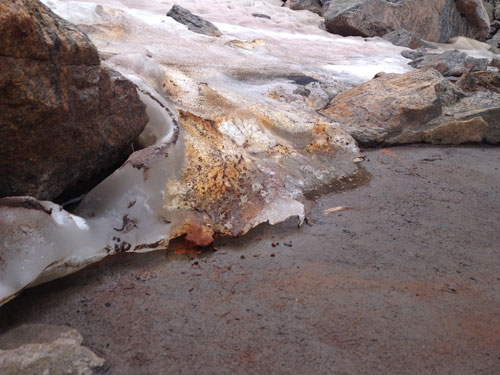Source: Journal of Geophysical Research: Biogeosciences
At first glance, glaciers may appear lifeless, yet these icy flows bear thriving microbial communities, as well as nutrients and metals, that escape in meltwater and shape downstream ecosystems.
Not all glaciers are created equal: Different types of glaciers in different locations release different materials in meltwater. However, this variation has been poorly documented. Now, Fegel et al. have characterized the different meltwater compositions of glaciers in the western United States. They describe which characteristics depend on glacier type, location, or both.
In the summers of 2012, 2013, and 2014, the researchers collected meltwater and sediment samples from glaciers in the Cascade Mountains, the Rocky Mountains, and the Sierra Nevada Mountains. These regions feature different climates, slopes, elevations, and underlying rock. The team examined 25 classic alpine flows and 24 rock glaciers, which consist of coarse rock fragments bound together and lubricated by ice.
For all three regions, rock glacier meltwater was warmer, less acidic, and more conductive than ice glacier meltwater. Rock glacier meltwater also had higher concentrations of silica; total dissolved nitrogen; nitrate; and calcium, potassium, magnesium, and strontium ions. Ice glacier meltwater had higher levels of ferric iron, manganese (II), and ammonium. The scientists also found different organic (carbon-related) characteristics for rocky glaciers versus ice glaciers.

Ribosomal DNA sequencing revealed different microbial community compositions between rock glacier and ice glacier meltwaters as well. Rock glacier microbial communities were more diverse than ice glacier communities, and certain species were abundant in meltwater from both glacier types.
When the team considered regional differences, they also found location-specific trends in temperature, conductivity, metal concentrations, and nitrate and ammonium concentrations. Dissolved organic carbon levels did not vary by location, but other organic matter characteristics did. Microbial community composition also varied on the basis of region, with the Rocky Mountain samples being the most diverse.
The results suggest that glacier type determines the concentration of released substances and the complexity of released organic materials. Meanwhile, geographic region dictates which rock type is weathered and the rate and intensity of weathering.
Geographic region also affected the concentration of nitrogen-bearing compounds in meltwater samples. The scientists suggest this is because of region-specific differences in atmospheric nitrogen incorporated into the glaciers. In fact, glacier meltwater composition may give a lagging signal of earlier location-specific anthropogenic increases in atmospheric nitrogen and other substances.
With 10,000 rock glaciers identified in the United States, they are 5 times more common than alpine ice glaciers in some areas. In coming centuries, rising temperatures will melt rock glaciers and ice glaciers alike. However, rock glaciers melt more slowly and will likely stick around after ice glaciers disappear. Knowing their meltwater composition will help predict how they will alter downstream ecosystems in the future. (Journal of Geophysical Research: Biogeosciences, doi:10.1002/2015JG003236, 2016)
—Sarah Stanley, Freelance Writer
Citation: Stanley, S. (2016), Glacial meltwater features depend on glacier type and location, Eos, 97, doi:10.1029/2016EO048265. Published on 21 March 2016.
Text © 2016. The authors. CC BY-NC 3.0
Except where otherwise noted, images are subject to copyright. Any reuse without express permission from the copyright owner is prohibited.

